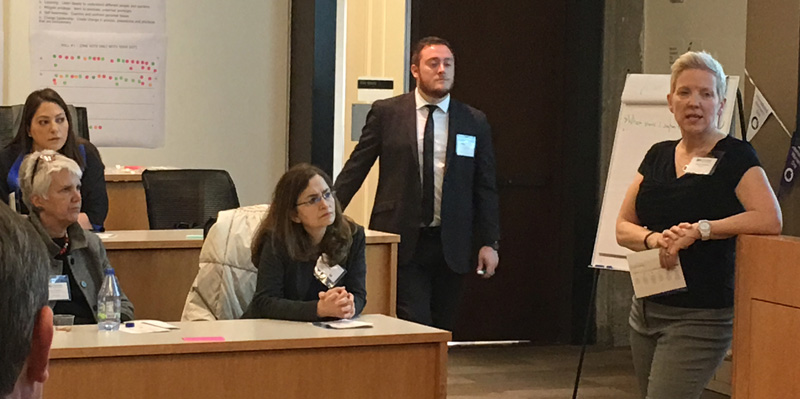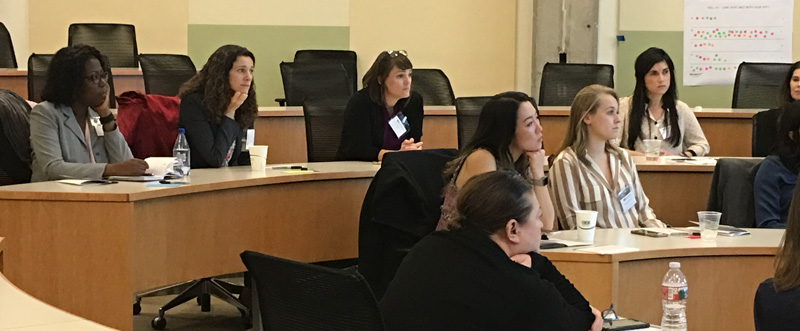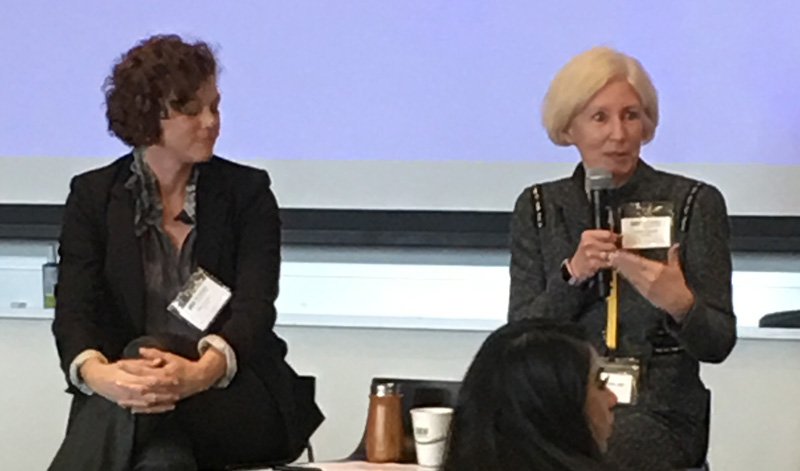By Anne Evers, FWSF MarComm Co-Chair
On March 7, at the FWSF International Women’s Day conference, participants broke into smaller groups to attend three of five roundtable discussions. These roundtables, led by well-known subject matter experts, focused on pressing topics facing women in finance today. Here are some key takeaways from the afternoon sessions:
The Language of Inclusion— Donald Duggan, Former Senior Executive Vice President, Head of Banking Services & Chief Diversity Officer at Bank of the West, and Marilyn Nagel, Chief Learning Officer, SAMI game, and CEO of Ready-Aim-Aspire

At the beginning of the session, the presenters had a list of questions ready for participants. In this group exercise, they requested that every time they asked a question, those of us who had had that experience should stand up. Questions included “Were you born outside the U.S.?” “Have you ever been made fun of because of your accent?” “Did your family struggle financially?” “Have you ever been passed over for an opportunity because of your gender, race, etc.?” “Have you ever been called a derogatory name?” “Has someone spoken to you inappropriately and you wish you had responded and didn’t?” Pretty much everyone in the room was standing for at least one of the questions and it helped us all see just how much we have in common. Diversity and inclusion affects us all.
Discussion centered around the barriers women face in the workplace, the inequality in their access to mentors and sponsors, women’s aversion to taking risks because of fear of failure, and the need to develop a network of mentors, sponsors, and allies. Presenter Donald Duggan, who helped design Bank of the West’s Diversity and Inclusion program, stressed that more white men need to be on board for women to really make progress. Duggan said based on the current rate of growth, gender parity in the boardroom is now expected to be achieved by 2048 (Equilar Gender Diversity Index). We are making progress, but there is still a long way to go.
The Art of Allyship—Pamela Hopkins, PhD, Owner and Managing Partner, Enact Leadership, and Flavio Bravo, Graduate Intern, Office of Diversity Engagement & Community Outreach, University of San Francisco

What is the mindset of an “ally?” Pamela Hopkins and Flavio Bravo facilitated a discussion on how we all can contribute to transforming organizational culture. They posted scenarios around the room that took into account real-life situations regarding race, socio-economic status, and gender. Participants broke into small groups to discuss various options in the scenarios and how to acknowledge our own biases, recognize acts of micro-aggression, educate, initiate discussion, and become an ally.
Key takeaways from the session included insights into how to become an ally, including:
Addressing Implicit Bias — Molly Anderson, CEO, and Faye Sahai, Senior Director Innovation & Inclusion, Exponential Talent, LLC

Given the recent media coverage of implicit bias, this event was timely and relevant. Whether in the workplace, the community or in sports, bias is pervasive. And we can all do something about it. Molly Anderson and Faye Sahai led participants through exercises to help them recognize what “implicit bias” is, its impact in the workplace, and how we can disrupt it. These biases, which encompass both favorable and unfavorable assessments, are activated involuntarily and without an individual’s awareness or intentional control.
The presenters gave an example of a study that was done where two interviewees, male and female, with the exact same qualifications, applied for a job. Study participants watched videos of the applicants and commented. Their comments showed their implicit bias regarding the female interviewee’s qualifications versus the male’s and the focus on personality and style. The study participants in the video were surprised by their own attitudes.
The presenters gave some guidelines and resources for disrupting implicit bias and learning more about it. These included:
Knowing Your Worth – Project Worth—Emma Reilly, Vice President, Head of Technology Strategy & Execution, Lending Club

Women talk about a lot of things, but they usually avoid talking about money. Four former BlackRock executive women, the founders of Project Worth, believe that discussing money shouldn’t be seen as a taboo. One of the founders, Emma Reilly, led the roundtable.
The session started with a video of various women answering the question, “What I wish I had known” about money management. Many voiced their lack of confidence regarding their finances, and their tendency to defer to spouses and partners. Project Worth co-founder Heather Pelant, managing director of Baker Street Advisors, said in an online interview, “What we found is that it unleashes a lot of conversation when you pose a few questions like, ‘What do you wish you would have known? What is your very best money lesson? What do you wish women knew?’This begins to unearth women’s ability to talk about money and topics related to it.”
In the session, many topics were covered about gaining financial savvy, including:
Paving the Path for Women to Serve on Corporate Boards – Donna Hamlin, PhD, CEO of BoardWise, and Danna Lewis, Chief Operating Officer, Athena Alliance

Ready to take a seat at the board table? Donna Hamlin and Danna Lewis discussed determining your readiness to serve on boards and crafting your professional development agenda. Donna has 30 years of corporate, governance, and strategy consulting experience and Danna works to accelerate gender parity in the boardroom.
They gave participants a handout with seven tips to help explore their readiness and to learn more about the commitments involved with board participation.
View roundtable leader biographies
Teveia Barnes, FWSF IWD Keynote Speaker: It Takes Courage, Tenacity and a Belief in Oneself
By Marianne LaPorte, FWSF MarComm Co-Chair
Panel Discussion: Overcoming Obstacles and Sharing Success Stories
By Linda Wagner, VP, FWSF MarComm